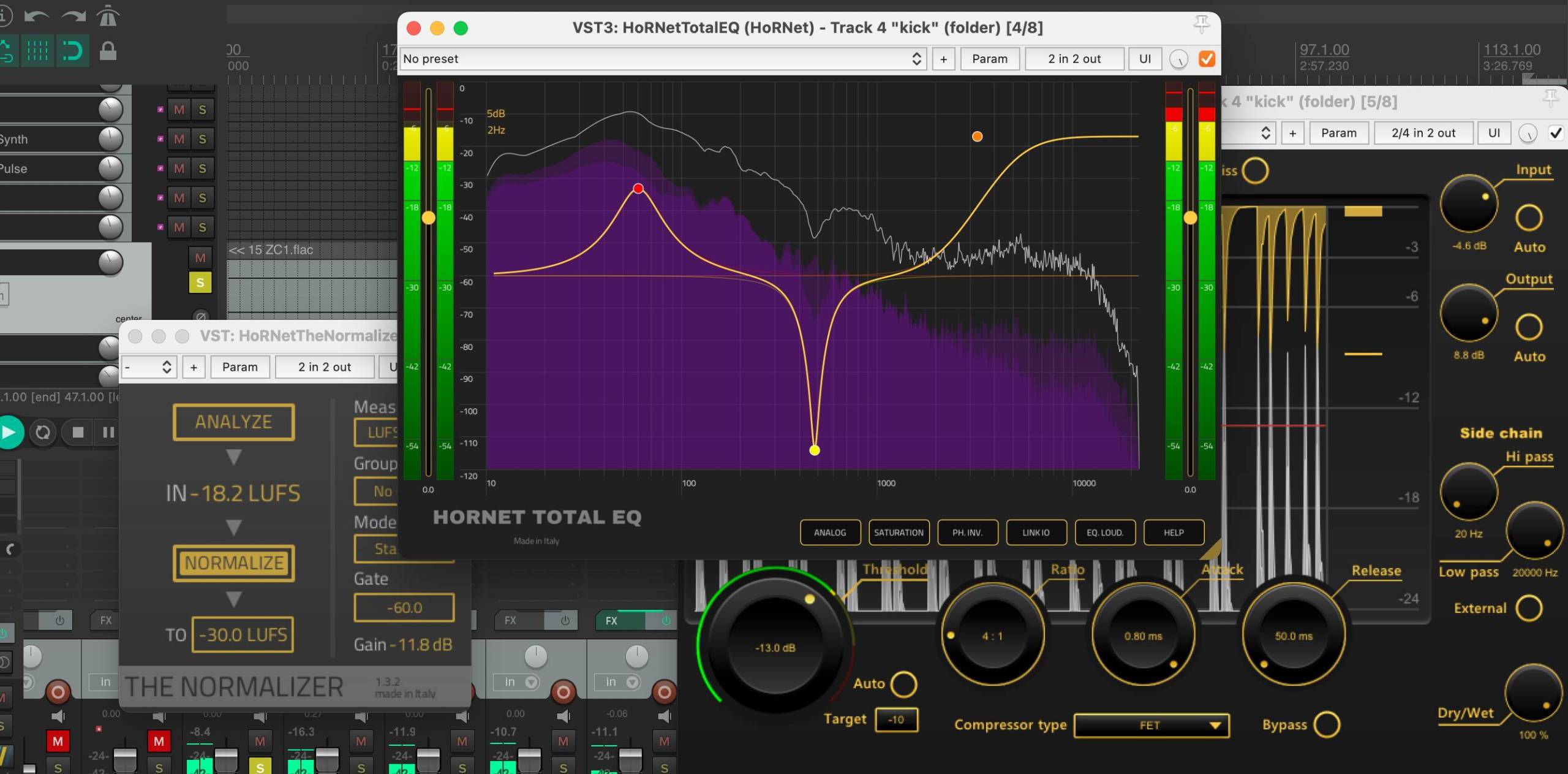HoRNet ChannelStrip 90% off with the code CHAN90 for the next |
In this webinar Saverio will show you how to use our Hornet Total EQ

This video is a recording of the webinar that took place on March 23, 2022, where we explored TotalEQ, our versatile digital equalizer featuring analog emulation and saturation. In this session, we provided an in-depth look at how to utilize this powerful tool in your mixing process to achieve professional-quality results. Whether you’re a seasoned producer or a beginner, TotalEQ offers a wide range of possibilities to enhance the quality and depth of your mixes, making it an essential tool for any modern producer.
We began by detailing each function of the EQ, explaining how each control works to shape your sound with precision. Special attention was given to the unique features of saturation and analog emulation, which set TotalEQ apart from other digital equalizers. The analog emulation in TotalEQ aims to bring the warmth and musicality typically associated with analog gear to your digital workflow. Many digital equalizers can sound sterile or overly clinical, but TotalEQ adds a touch of that vintage analog feel, providing a more organic, musical quality to your mixes.
The saturation feature in TotalEQ is particularly powerful. It can be used creatively to add color, depth, and a bit of harmonic richness to your tracks. In the webinar, we discussed how saturation can be used not just for tone shaping, but also to bring out the character of specific elements in your mix, whether it’s vocals, guitars, or drums. By applying saturation, you can make individual elements stand out more, giving them a more dynamic and vibrant presence within the overall mix.
One of the key highlights of TotalEQ is its flexibility. It offers an incredibly flexible set of controls, including the ability to adjust frequency bands, Q-factor, and gain to target specific parts of the frequency spectrum. With TotalEQ, you can shape your sound with great precision, allowing for both subtle adjustments and more dramatic tonal shifts. This versatility makes it an excellent choice for a wide range of applications, from mixing individual tracks to mastering the final product.
After thoroughly covering the technical aspects of the plugin, we moved on to a practical demonstration, where we used TotalEQ to quickly mix a track. This segment was designed to show attendees how the plugin functions in a real-world scenario and how it can be applied effectively to enhance various elements of a mix. We demonstrated how to use TotalEQ to mix different elements like vocals, drums, bass, and synths. The practical session gave attendees a chance to see exactly how to apply the plugin’s features, such as its saturation and analog emulation, to improve each element of the track.
Throughout the demonstration, we emphasized how TotalEQ can be used to create a more balanced and cohesive mix. Whether you’re working with a single instrument or an entire mix, the plugin allows you to shape the sound in a way that ensures everything fits together nicely. We highlighted how the analog warmth from TotalEQ’s emulation feature can smooth out harsh digital sounds, making them feel more natural and organic in the context of the overall mix. This makes TotalEQ a fantastic tool not just for EQing but also for bringing a bit of that classic analog vibe to modern digital productions.
As we progressed through the demonstration, we also discussed the practical uses of each EQ band and how to tailor your EQ settings to suit different types of music. Whether you’re mixing acoustic music or electronic tracks, TotalEQ gives you the flexibility to adjust the sound to your liking. For instance, when mixing vocals, you can use the EQ to boost mid-range frequencies for clarity and presence, while also applying a bit of low-end cut to prevent muddiness. For bass-heavy tracks, the EQ can be used to tighten up the low end, while for synths, you might focus on enhancing the highs to give the sound more air and brightness.
By the end of the session, viewers gained a deeper understanding of TotalEQ’s capabilities and how to use it to improve their mixes. The webinar was designed not only to show the theory behind the EQ and its unique features but also to provide practical insights into its application in a professional setting. Viewers were equipped with the knowledge of how to use the plugin to improve the clarity and definition of their mixes, while also adding a layer of warmth and musicality that’s often missing from digital productions.
This video serves as a valuable resource for anyone looking to get the most out of TotalEQ and learn how to apply analog warmth and saturation to their digital mixes. It provides a solid foundation for understanding how to use an EQ in the most effective way possible, ensuring that your mixes stand out with both clarity and musicality. Whether you are new to mixing or an experienced engineer, this webinar will help you unlock the full potential of TotalEQ, making it a key component in your mixing process.
TotalEQ is not just about making things sound good; it’s about making things sound better—creating mixes that are more defined, vibrant, and professional. By integrating analog-style features like saturation and emulation, you’re able to take the best of both worlds: the precision of digital tools combined with the warmth and depth of analog equipment. This allows for a more dynamic and expressive mix that will elevate the quality of your productions.
In conclusion, this webinar offers valuable insights into how to use TotalEQ as part of your mixing workflow to achieve professional-quality results. Whether you’re aiming to add some warmth to your tracks or need precise EQ control to clean up your mixes, TotalEQ is the perfect tool for the job. Don’t miss out on the opportunity to learn from the experts and make your mixes sound better than ever before!
Versatile precision equalizer with analog emulation